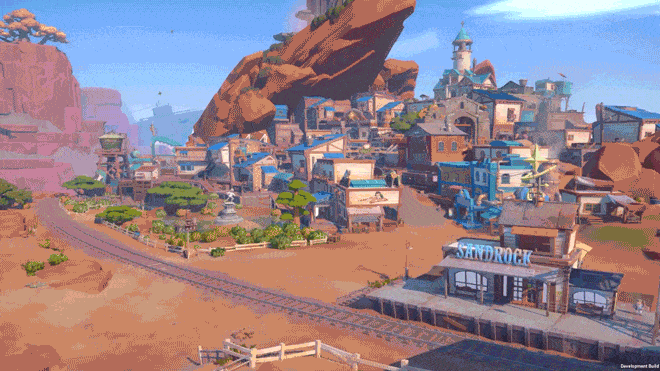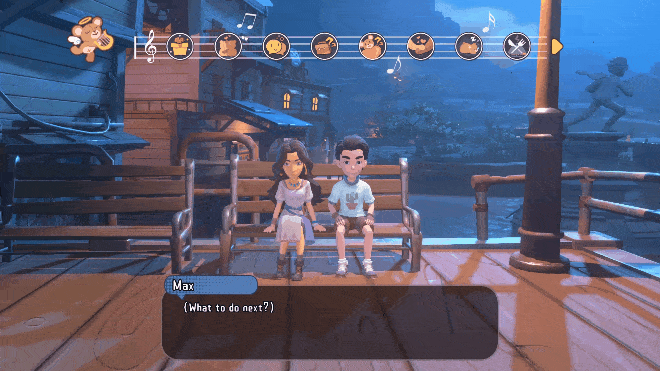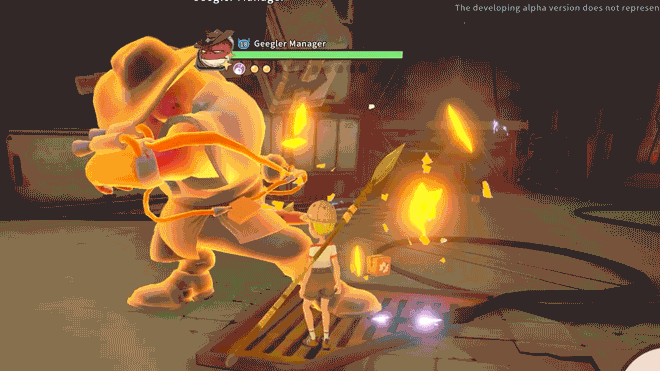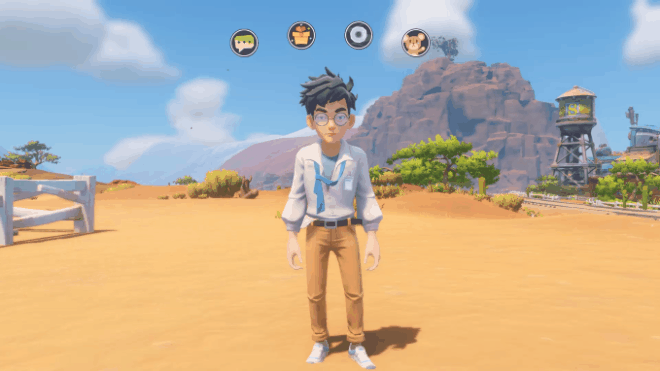
Fantasy Toonz: Embers of Creation
The Great Creator Raist, being as bored as he was, created 12 demi gods to keep himself entertained. They soon became bored themselves so they created a world with all kinds of races to keep themselves entertained. Filled with jealousy, but fearing rebellion, Raist manipulated the races into a false religion to fight against the demi gods. Raist then suggested the demi gods give their children magic as a reward for their loyalty and to combat this new false religion that was threatening the will of the gods. When the demi gods realized that the Raist was the one behind the false religion, they took all the magic from their childen and used it to destroy The Great Creator. Raist was destroyed and the embers of what was left smashed down upon the planet, shattering it into an untold number of pieces and destroyed most of the life on the planet.
Read More: Best RPG Dungeon Crawler Games.

Nuclear Drifter
I enjoy post-apocalyptic games and found Nuclear Drifter a fantastic “old school” game. The game play and controls are simple and easy to learn - point and click. The graphics and animation are pretty good especially for an old school designed game. The background music is rather relaxing. I usually turn off background music; but, left the game running, even when I was not playing, for my own background sound. The back story and general story line could use a bit of work, I was a bit surprised to have the game suddenly stopping with a cliffhanger message about future updates leaving two unfinished quests. Overall, I found Nuclear Drifter enjoyable, relaxing to play, and I am looking forward to the update so I can finish those quests.
– Real player with 9.9 hrs in game
Read More: Best RPG Post-apocalyptic Games.
SAVE THE GAME BEFORE YOU ENGAGE IN A FIGHT WHERE YOU MIGHT LOSE. When you nail the art of remembering to save the game, the gameplay is fun and the music is cool
– Real player with 8.7 hrs in game

Tree of Mu
Tree of Mu is a 2D Procedurally Generated Open-World RPG which takes place in a viking land called Mu on planet Earth. This land was ruled by many kings and destroyed by many wars, but such cycle would not last. One of the kings of Mu, Eric, The Mage, couldn’t live with the fact that his days as a ruler were to end when his people, because of so many deaths and cruel decisions by Eric, gathered in front of the castle to claim his throne, he then shouted to his crowd as a last act of courage: “I will last and conquer this land as long as Mu lives”. Eric then fled and searched for a misterious power on a jorney towards the Tree of Mu, such tree were as big as the land itself and its roots would cover all the continent. Eric sat alongside the tree and whispered misterious words for days… Weeks had passed and Eric would be covered by roots and almost completely swalled by the tree itself. Once the ritual was done, Eric, The Mage, not only had died, he had buried his own soul inside the Tree of Mu, now known as Yggdrasil. As he lived inside Mu’s lifeforce, he could use the power of the four elements, and with such, he enchanted the rivers and that would change all the life that once lived in Mu. Giants, Demons, Goblins… They all came from Eric’s birth of this new world. To protect his creation, Eric raised the largest wall he could possibly raise, a wall made of an unbreakable magic ice, separating the known Earth of this magic and misterious land.
You. Warrior. Mage. Hunter. You will uncover all the misterious and fortunate adventures that are hidden in this land, but be aware, merciless monsters and dangerous animals await you. Good Luck and may the gods be with you.
Main Features:
-
Procedurally Generated World sized around 6 million blocks.
-
Fog of War.
-
Hundreds of different structures scattered around the world with bosses and treasures on some of them.
-
Choose one faction out of 3 to play: The Hammer (Dwarves), The Shield (Humans), and The Arrow (Elves).
-
Every item in the game is different from each other, having a system that modifies items based on its rarity, level and type.
-
Combat system inspired in old school RPGs.
-
Very intelligent AI that is able to combat with each other on a faction based reputation system.
-
Very large Passive Tree with multiple different paths to experiment with.
Read More: Best RPG 2D Games.

Anima Forest
at least it’s a good start. please keep improving it.
– Real player with 3.4 hrs in game
This game is probably going to be really good when it is finished, So far, while the game is difficult, it is really fun. The art style and different enemies are very unique and are different from other survival games I have played. Now knowing that the game is still in early access, there are a few things I would change. First, adding wasd controls would make the game a lot easier to control. Secondly, I think the days should be longer. The amount of time in the day is not enough to make food, gather materials, and set up a wall. Overall though, for a dollar, this game is really good and I would recommend it for anyone who is looking for a unique survival game with a good challenge to it. (also if you like animals)
– Real player with 3.0 hrs in game

Dragon And Home
A game built to desire the hungry fiends awaiting Hytale. In it’s early stages it has compromise, aspiration, beauty.
Those not worthy to grind, shall formally fall under as “lackluster and lazy” those who do not aspire to strive as well.
This game is in no shape perfect, yet describe to me a game that is? We see games like these as, “another minecraft ripoff”
I see a game like this as the future. Plenty of people whining, crying, to a what? 10 man Dev team? About how “oh the healing is the worst, the servers suck, it’s too much, it’s too hard” nonsense. Write a review on life while you’re at it, nobody can bug fix that.
– Real player with 654.3 hrs in game
– edit after holloween patch –
The latest patch has gone live and the old review no longer applies so I must change it.
The game is still bare-bones. The content is still balanced around the lv 20 cap so it is natural. What IS there is fine.
– THE BAD –
Here are what I think are still the problems plaguing the game:
- vigor is still a problem
Vigor (as previously described) is the system used to gate certain activities. The initial iteration of it had vigor attached to harvesting. T1 materials such as stone, herb did not cost vigor. T2 materials such as copper, flax cost 1 vigor. T materials such as iron, cotton cost 2 vigor. This system incentives hoarding materials. The new system attached vigor to crafting gear (weapon and armor).
– Real player with 502.5 hrs in game

Lantern Forge
GAME IS ABANDONED & FULL OF BUGS!!!!! A half completed game. Last update was in 2015 I think.
7 years later (haven’t played since 2014)……Hit a major game breaking bug.
After 10 hrs of game play, I’m unable to place any workstations. Picked up ones I did place, can’t put them back down….sigh…..
No point in continuing that game anymore. Last time I played (in 2014) of the 6 games, only one character made it to level 50. The other games had to be abandoned to game breaking bugs.
I come to find out I have to restart the game every so often or major bugs will crop up. This includes rendering new portions of the map. Where it’s be dark, inaccessible until you restart (maybe)..
– Real player with 130.5 hrs in game
Playing this game is alot like starting a project. Unless you have a clear idea of what you want to do, it’ll be rather hard to figure out the best way to enjoy this. Fortunately, they have alot of variety to the game and what you are able to do with it, as well as giving you a chance to enjoy all the skills and classes you want to take or experiment with!
Lantern Forge can be classified as a basic RPG, but with quite a few twists. There are no real classes there, since you’re not limited to only choosing one set of skills. Your equipment can be mixed and matched, so if you like to wear a mage’s armor, but prefer to go Gandalf and swinging swords around, it’s all good. There are some npc’s to start with after you gather all the materials for a town center, so you’ll have more ways to earn money, like selling crops or ditching extra gear you don’t need.
– Real player with 36.6 hrs in game

My Time at Sandrock
My Time at Sandrock-Just like My Time at Portia, My Time at Sandrock takes place in a wholesome post-apocalyptic world 300 years after the Day of Calamity destroyed most modern technologies.
After accepting a job offer to become Sandrock’s newest Builder, you’ll arrive in the wild and rugged city-state, where it’s up to you and your trusty tools to restore the community to its former glory. Gather resources to build machines, befriend locals, and defend Sandrock from monsters — all while saving the town from economic ruin!
Key Features

Transform a run-down workshop into a well-oiled production facility! Use an intricate set of machines to process materials and produce parts of huge structures before assembling them piece by piece to help Sandrock flourish.
Create hundreds of unique items at the worktable to decorate your homestead, give gifts to Sandrock’s residents, or assist with community requests.”

Explore vast deserts surrounding the city-state of Sandrock. Dive into ruins to dig for Old World relics, seek our materials in hard-to-reach locations, or spend time relaxing in Sandrock with your neighbors.


Experience a detailed story complete with hundreds of sidequests and over 30 all-new characters. Spend time getting to know Sandrock’s residents, uncovering backstories, and making meaningful connections along the way.


Quickly shift between melee combat and third-person shooting mechanics in dynamic action battles.Use the new weapons and defense break mechanic to your tactical advantage, or boost your stats to simply smash through battles!


Spend experience to level up your Builder and unlock skills. Become a master crafter, specialize in combat, or focus on social interactions with skills that suit all playstyles.

-
Use your workshop’s profits to turn the empty prairie into farmable land;
-
Grow crops for extra cash or transform them into delicious dishes;
-
Attend festivals with Sandrock’s residents;
-
Find secrets and much more!

Both Portians and brand-new Builders who have never set foot in Portia will find a fun new world with lots to explore at their own pace, along with divergent NPC stories to enhance replayability. Experienced Builders will find everything you enjoyed about My Time at Portia and more, and you will feel right at home in the delightful life-sim RPG that is My Time at Sandrock.

The Dark: Survival RPG
Nice little game. Can’t beat it for the price. Kind of a bit of skyrim feel to it. Support is awesome. Found a couple of bugs and spoke directly to the dev through discord and it was fixed within about 8 hours. I can’t wait to see what becomes of this little gem.
– Real player with 26.2 hrs in game
This Game Is A lot of fun, now yes it does still need work however what early access game doesn’t? I have paid much more than what this dev is asking for half the fun which tells me he cares more about his/her game than making a quick few dollars and those are the indie games i love and adore. Can’t wait to dive deeper into it as it’s going to make a fun lets play :) One thing that I really hope gets fixed is the UI It is so teeny tiny that even on my computer monitor i have to lean in to read what it says and the images are so tiny you can’t make them out. I am sure this will be corrected as i did see in tattmans video that it was much bigger yesterday :) Keep having fun creating this game dev and it’s going to grow into something epic, you have an AMAZING start! The music and lighting made it immersive however i would maybe make night time a little later lol it went from bright to dark however it did make for me to get on the edge of my chair to ensure nothing was coming to get me lol I really enjoyed it and will be playing a lot more. (once i can see the UI, lol) :)
– Real player with 3.5 hrs in game

Vagabond
Greetings Adventurer!
In Vagabond, you will have the opportunity to explore vast procedurally generated worlds and meet their numerous inhabitants. You start in the middle of nowhere with no memories or possessions. It’s up to you to forge your destiny, become a famous treasure hunter by searching dangerous dungeons, the best blacksmith in the whole country or a benefactor by helping the villagers who need you. Who will you become?
Blending elements of traditional role-playing games with the freedom of sandbox-style games, Vagabond is a unique experience. Moreover, you can share your adventures with your friends as Vagabond was designed from the ground to support multiplayer.
Features
-
Create and customize your character
-
Explore procedurally generated worlds and travel across many different biomes which have their own riches and dangers
-
Visit cities and meet hundreds of NPC who have a lot to offer: they can teach you new skills, buy or sell you goods or tell you the latest rumors. And if you feel good in one of the villages, you can buy a house and become one of the villagers
-
Complete quests to help locals and earn rewards
-
Fight monsters in dungeons and get rare treasures
-
Gather resources by chopping trees, mining ores in caves, growing crops and killing monsters
-
Craft items such as armors, weapons, meals and furniture
-
Buy and furnish your home
-
Share your adventures with your friend with networked multiplayer (through LAN or the Internet)
Demo
Vagabond is still under active development, many new features are coming shortly:
-
Magic with spells, magic wands, wizards and alchemy
-
Guilds with news quests and game mechanics
-
Lore generation to provide a history and legends to each world
-
More locations to fill the world such as castles, temples, ruins, etc.
-
Better dungeons with more complex structures and new types of rooms
If you want to support the game, you can play it now. If you have any remark, I would be happy to have your feedback, you can send me an email to pierre@vagabondgame.com or come and chat on Discord . Help me shape Vagabond’s future!

Vitality

It is the dawn of civilization: the fight for survival is fierce, resources plentiful, and empires nothing more than begrimed huts on the brink of collapse. The world is your sandbox and you can choose to rise to the top or fall with the weak. Vitality is a game which places you into a fictional world at the dawn of human civilization, faced with the task of guiding your people through the tests of time. Grow your empire from dirt and sticks to prosperity and greatness. No longer are you limited to the axe over your shoulder or the ground beneath your feet; instead, utilize the world’s most powerful resource as you conquer unknown lands and push the boundaries of civilization: people!
A sandbox at its core, Vitality is a game designed to take you on a journey across human history as you progress in skills and knowledge. On top of its open world, interactive-sandbox foundation, the core mechanic of Vitality is the advancement of knowledge through the completion of NPC quests, world exploration, and the fulfillment of skill progression trees. In Vitality, you will explore four distinct ages through the guidance of a loosely structured narrative—each providing a unique thematic focus and gameplay objective. Grounded in its atmosphere, Vitality features many familiar mechanics popular to the sandbox genre—each tailored specifically to ensure a unique, fulfilling, and enjoyable experience.
Gameplay Synopsis & Core Mechanics:
Vitality Age Progression
Vitality features four distinct ages, or “eras”, designed to reflect the pivotal moments in our real historical growth as a civilization. Each age is built upon the progression of the previous, with each featuring distinct gameplay focuses and thematic objectives. Behaving similar to “chapters” of an overarching narrative, the different ages are designed to guide the player in discovering gameplay mechanics, encountering unique situations, and experiencing an evolving and dynamic world.
Stone Age – The Stone Age is the first age you will encounter as you begin your journey in Vitality. Rough, tough, and unforgiving, the Stone Age is designed to depict our earliest struggles as an emergent hunter-gatherer species. With some creative liberties taken—such as the inclusion of dinosaurs and other prehistoric beasts—the Stone Age is designed to test one’s abilities to survive. As such, the Stone Age introduces you to the beginnings of the NPC quest and posse systems, the Vitality health & survival meter, and many other supplementary survival-based mechanics such as an interactive temperature system, weather, and unique world events.
Tribal Age – As the Stone Age ends, you will transition into the Tribal Age. With advancing technology and the discovery of agriculture, the beginnings of civilizations start to emerge as permanent settlements rise up. The Tribal Age expands the extent of the NPC quest and posse systems, introducing several new mechanics that will allow you more in-depth management of various NPC relations. Moreover, with the emergence of tribes, conflict inevitably follows. Be prepared to manage the favor of your friends and foes!
Medieval Age – Given time, the small tribes of the past expand and conquer, spreading their influence throughout the region. With growing numbers, advancing technology, and a thirst for power, empires form and castles scatter the lands. The Medieval Age throws you into an era of royalty—one split by the dynamics of wealth and poverty. Introducing several new building and crafting opportunities, the expansion of settlement politics, and several new item processing modes allowing capabilities such as in-depth cooking and metallurgy, the Medieval Age truly is a time of knights and squires!
Industrial Age – Medieval Age technology cannot support the growth of civilization indefinitely, however. As such, it was necessary to invent new ways to create and automate. The Industrial Age puts you in a time of rapid technological advancement—thematically designed with a steampunk-esque style in mind. Introducing you to the two new Electricity and Mechanisms mechanics, you will be able to create complex machinery and item processing mechanisms. How far can you take these new modes of automation?
Advanced NPC Mechanics
Quests – NPC quests are a pillar of Vitality’s core gameplay. Designed to loosely guide you through a structured narrative, as well as a way to obtain new goods, increase NPC favor, and discover new gameplay mechanics, NPC quests were created to be both expansive and interesting.
Favor – Your relation with NPCs is not guaranteed. Instead, their interactions with you are based on a “favor” value. You can increase NPC favor by completing their quests, supporting the village, or saving their lives. Whilst low favor NPCs will attack you and your tribe if provoked, high favor NPCs offer many perks!
Posse System – Outside of quests, NPCs can be useful assets to aid you in your ambitions and adventures—if you can earn it, that is. With high enough favor, you can recruit NPCs to join your party. Whilst in your party, NPCs will follow you around the world, each providing special abilities, benefits, and behaviors based on their specializations. For instance, recruiting hunter NPC’s will aid you in exploring untamed wilds, miner NPCs will mine ores with you as you explore complex cave systems, and healers can attempt to revive you if you meet an unfortunate fate. The NPC Posse system is powered by a robust, advanced NPC AI pathfinding architecture we created to ensure that NPCs can always keep up!
Building, Crafting, & Knowledge
Building & Crafting – Vitality features standard building & crafting mechanics typical of the genre. Blocks, items, furniture, and utility objects can be collected and crafted as you explore and advance in the game. To expand on building capabilities, Vitality features a “micro block” Block placement system, allowing you to turn any place-able block or material into different sub-shapes, such as stairs, slabs, slopes, and corners.
Recipe Books – Crafting recipes (in the main Story Mode) are segregated through a collection of “recipe books” that you will acquire as you play the game. Obtained through exploration, quest rewards, and skill tree fulfillment, recipe books create an intuitive way to expand your crafting knowledge and capabilities. Along with providing the ability to craft new sets of items, recipe books also provide comprehensive information about each recipe it contains, allowing quick reference to general item information, uses, and how they can be obtained.
Story & Collection Books – Alongside recipe books, Vitality will have a host of story and collectible books that you can discover throughout your playthroughs. These books will contain funny short stories, lore, and general anecdotes to entertain you in your journeys!
Multiplayer
Vitality also features an online multiplayer co-op mode, fully compatible with the main “story” as described above. Vitality’s multiplayer mode is optimized to be be played between groups of friends sized 2-8.
Release Information
Vitality is currently on track for a Q4/Winter 2020 full release. We will post more information about the specific date as we move closer towards completion. Vitality will not be released as an Early Access title.
#### Community & Contact
If you want to follow the development of the game more closely, or chat with us about the project, join our Discord Server !
